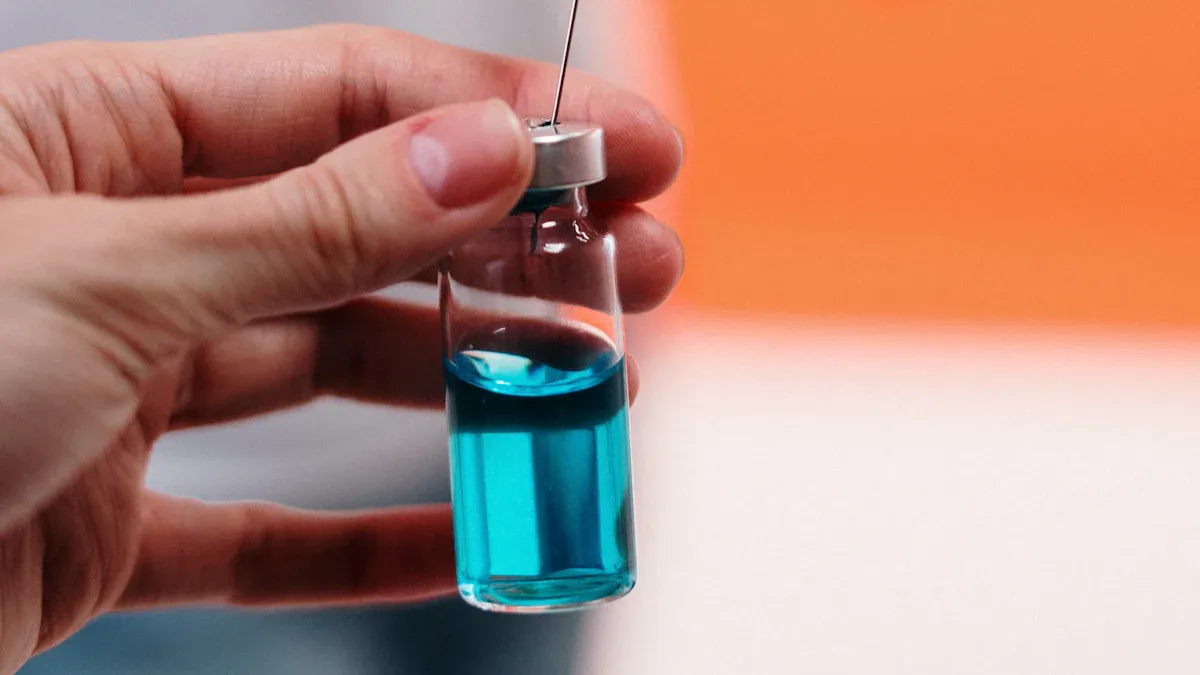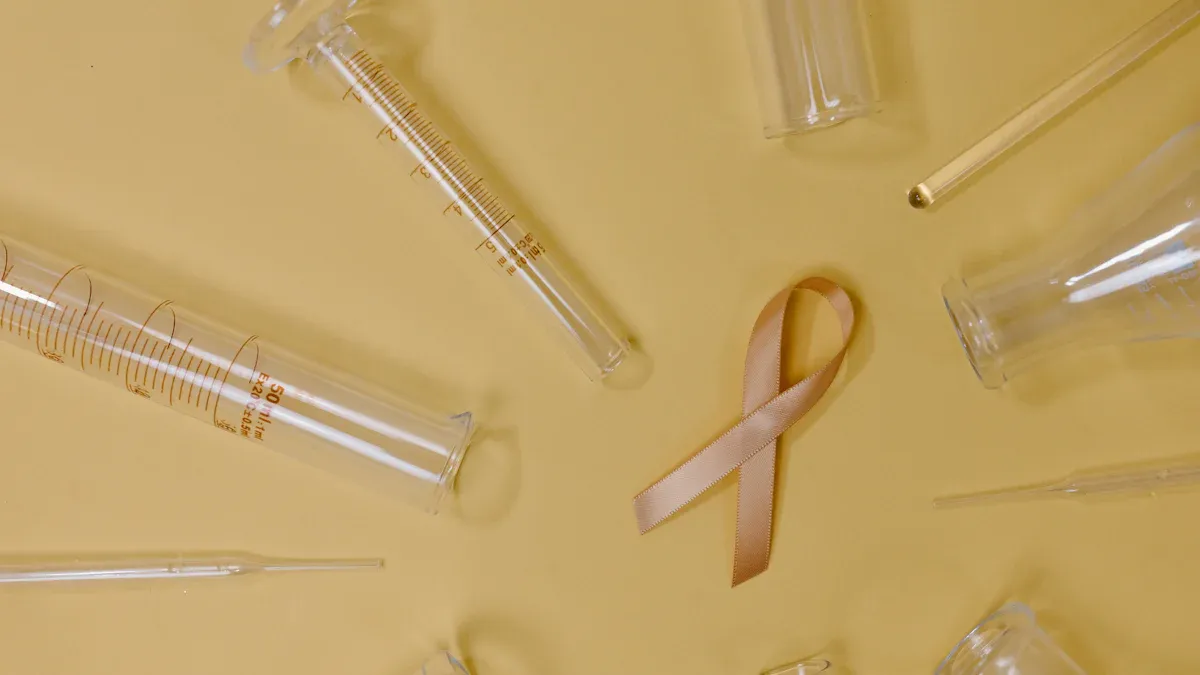How Acute Myeloid Dendritic Cell Leukemia Is Treated

Acute myeloid dendritic cell leukemia is a rare and aggressive form of blood cancer. It primarily affects older adults, with over half of the patients being above 65 years old. The five-year survival rate for this group remains below 10%, emphasizing the urgent need for innovative treatments. Traditional therapies, such as chemotherapy and stem cell transplantation, often result in severe side effects. Dendritic cell-based immunotherapy offers a promising alternative by enhancing the immune system's ability to target leukemia cells. However, only patients who develop a specific immune response to the therapy experience lasting benefits, highlighting the variability in outcomes.
Key Takeaways
Dendritic cell therapy helps the immune system fight leukemia cells. It is less harmful than regular treatments.
Doctors take dendritic cells from patients and change them to fight cancer better. Then, they put the cells back into the body.
Studies show good results. Some patients have fewer cancer signs and live longer.
Using dendritic cell therapy with treatments like chemotherapy can make it work better. It also lowers the chance of cancer coming back.
Scientists are working to fix problems with this therapy. They want to make it easier and better for people with acute myeloid leukemia.
What Are Dendritic Cells?
Role in the Immune System
Dendritic cells serve as the immune system's versatile controllers, playing a pivotal role in initiating adaptive immunity. These cells are antigen-presenting cells that process foreign substances, known as antigens, and display them to other immune cells. This function bridges the innate and adaptive immune systems, ensuring a coordinated response to threats.
Characteristic | Description |
|---|---|
Role | Versatile controllers of the immune response, initiating adaptive immunity. |
Morphology | Defined by specific cell morphology. |
Markers | Expression of specific markers that can change under inflammation or infection conditions. |
Functional Attributes | Ability to migrate to T cell areas and activate T lymphocytes. |
Immature State | High endocytic activity and low T-cell activation potential. |
Maturation | Transformation into mature dendritic cells that present antigens to T cells. |
Antigen Presentation | Process and present antigen material on the cell surface to T cells. |
Dendritic cells' ability to migrate and activate T cells highlights their importance in maintaining immune surveillance and combating infections.
Interaction with T Cells
Dendritic cells interact with T cells to combat diseases by presenting protein fragments from pathogens. This process involves major histocompatibility complex class I (MHC-I) molecules, which display these fragments on the dendritic cell surface. T cells recognize these fragments as foreign and become activated. The extensive endoplasmic reticulum in dendritic cells enhances their efficiency in loading antigens onto MHC-I molecules. This interaction ensures a robust immune response, targeting and eliminating harmful pathogens.
Importance in Cancer Treatment
Dendritic cells play a significant role in cancer treatment due to their ability to initiate tumor cell death. They achieve this through various mechanisms, even without additional activating signals. For instance, in patients treated with the TLR7 agonist Imiquimod for basal cell carcinoma, tumor-infiltrating dendritic cells were observed near dead tumor cells. This finding underscores their role in tumor cell death. Additionally, intra-tumoral injection of dendritic cells or treatment with dendritic cell-activating factors has been linked to reduced tumor growth and regression. These attributes make dendritic cells a promising tool in therapies for conditions like acute myeloid dendritic cell leukemia.
Dendritic Cells in AML Treatment

Collection from Patients
The process of using dendritic cells for treating acute myeloid dendritic cell leukemia begins with their collection from the patient. Physicians typically extract these cells from the patient’s blood or bone marrow. Specialized techniques, such as leukapheresis, isolate dendritic cells from other blood components. This method ensures a sufficient quantity of cells for therapeutic purposes. Once collected, the cells are preserved under controlled conditions to maintain their viability for further processing.
Modification for Therapy
After collection, dendritic cells undergo modifications to enhance their therapeutic potential. Scientists use advanced techniques to prepare these cells for targeting leukemia. Some of the most effective methods include:
Ex vivo generation of killer dendritic cells (KDCs) to improve their ability to attack cancer cells.
Adenoviral transduction, which enhances the functionality of KDCs.
Application of biological response modifiers to boost tumor-specific immunity.
Use of TLR agonists, such as Imiquimod, to improve dendritic cell survival and functionality.
Development of "super"-KDCs for direct administration into tumor sites.
These modifications enable dendritic cells to present leukemia-specific antigens more effectively. By doing so, they stimulate cytotoxic T-lymphocytes (CTLs) and natural killer (NK) cells to target and destroy leukemia cells.
Reintroduction into Patients
Once modified, the dendritic cells are reintroduced into the patient’s body. This step involves injecting the cells back into the bloodstream or directly into tumor sites. The reintroduced cells present leukemia-related antigens to T cells, activating a robust immune response. This process generates antigen-specific CTLs capable of recognizing and eliminating acute myeloid dendritic cell leukemia cells. Additionally, innate immune cells like NK cells contribute to the eradication of leukemia through non-specific cytolytic mechanisms. This dual activation of adaptive and innate immunity makes dendritic cell therapy a promising approach for treating this aggressive cancer.
Targeting Leukemia Cells
Dendritic cell therapy focuses on targeting leukemia cells by leveraging the immune system's natural mechanisms. Modified dendritic cells play a central role in this process. These cells present leukemia-specific antigens to T cells, which then identify and attack the malignant cells. This targeted approach minimizes damage to healthy tissues, unlike traditional treatments such as chemotherapy.
The therapy activates cytotoxic T lymphocytes (CTLs), which are specialized immune cells. CTLs recognize and destroy leukemia cells with precision. Additionally, natural killer (NK) cells contribute to the immune response. NK cells eliminate leukemia cells that evade detection by T cells. This dual activation of CTLs and NK cells enhances the overall effectiveness of the treatment.
Researchers have developed innovative strategies to improve the targeting of leukemia cells. For example, dendritic cells can be engineered to express specific proteins that enhance their ability to stimulate T cells. These proteins include cytokines, which boost the immune response. Another approach involves loading dendritic cells with leukemia-derived antigens. This method ensures that the immune system focuses exclusively on leukemia cells.
Note: The precision of dendritic cell therapy reduces the risk of side effects commonly associated with other treatments. This makes it a promising option for patients with acute myeloid dendritic cell leukemia.
Ongoing research aims to refine these techniques further. Scientists are exploring ways to increase the longevity and activity of modified dendritic cells within the body. These advancements could lead to more effective and durable responses in patients.
Effectiveness of Dendritic Cell Therapy
Clinical Outcomes
Dendritic cell therapy has shown promising results in clinical trials for acute myeloid dendritic cell leukemia. Studies have demonstrated its potential to improve survival rates and induce remission in patients. For instance, a trial using multi-genetically modified monocyte-derived dendritic cells (Ad-siSSF DCs) in post-transplant acute leukemia relapse reported a three-year overall survival rate of 48.9%, compared to 27.5% in patients receiving donor lymphocyte infusion (DLI). The complete remission (CR) rate reached 57% in treated individuals. Another study applied dendritic cell vaccines in patients with refractory or relapsed AML, confirming the safety and efficacy of this approach. Additionally, using dendritic cell therapy after chemotherapy-induced remission achieved an impressive CR rate of 83% in patients experiencing early molecular relapse.
Clinical Trial Setting | Description | Outcomes |
|---|---|---|
Post-transplant relapse | Multi-genetically modified moDCs (Ad-siSSF DCs) were used. | 3-year OS of 48.9% vs. 27.5% (DLI group); CR rate of 57%. |
Advanced disease setting | DC vaccines applied to refractory/relapsed AML patients. | Demonstrated safety and efficacy. |
After chemotherapy-induced remission | DC therapy used to prevent or delay relapse. | CR rate of 83% in early molecular relapse patients. |
Patient Responses
Patient responses to dendritic cell therapy vary depending on disease stage and individual factors. The objective clinical response rate has been reported at 43%. In relapsed or refractory AML cases, responses often result in temporary disease stabilization. However, in a second phase of treatment using Ad-siSSF DCs, a CR rate of 83% was observed in 12 patients. These findings highlight the therapy's potential to achieve meaningful outcomes, particularly in early intervention settings.
Comparison with Other Treatments
Dendritic cell therapy offers a less aggressive alternative to traditional AML treatments, which often involve high toxicity and significant risks. Chemotherapy, a standard treatment, has shown limited long-term survival rates, with fewer than 30% of patients achieving lasting remission. This figure drops even further for individuals over 65 years old. In contrast, dendritic cell therapy harnesses the immune system to target leukemia cells, potentially improving outcomes while reducing side effects. Traditional treatments have seen minimal advancements over the past two decades, emphasizing the need for innovative approaches like dendritic cell therapy.
Note: The precision and reduced toxicity of dendritic cell therapy make it a promising option for patients with acute myeloid dendritic cell leukemia.
Challenges in Dendritic Cell Therapy
Immune Resistance
Immune resistance poses a significant challenge in dendritic cell therapy for acute myeloid dendritic cell leukemia. Leukemia cells often develop mechanisms to evade detection by the immune system. These cells can suppress the activity of dendritic cells, reducing their ability to activate T cells effectively. Additionally, the tumor microenvironment in advanced leukemia cases often contains immunosuppressive cells. These cells dominate over anti-tumor immune effector cells, weakening the overall immune response. This imbalance makes it difficult for dendritic cell therapy to achieve long-lasting results. Researchers continue to explore strategies to overcome immune resistance, such as combining dendritic cell therapy with other immunotherapies.
Logistical Issues
The production and delivery of dendritic cell therapy involve complex logistical challenges. These include:
The need for two separate cell collections from the patient: one for tumor cells and another for dendritic cells.
The absence of interim storage options, requiring precise timing for apheresis collection.
The necessity of maintaining a chain of custody documentation throughout the process.
The requirement for a unique identification number to track cells during collection, transportation, and storage.
These steps demand meticulous coordination between medical teams and laboratories. Any disruption in this process can compromise the therapy's effectiveness. The complexities of autologous therapies, which rely on the patient’s own cells, further add to these logistical hurdles.
Limited Availability
Dendritic cell therapy remains limited in availability for many patients with acute myeloid dendritic cell leukemia. In relapsed or refractory cases, clinical responses are often temporary, with only short-term reductions in leukemic cell load. This limits its effectiveness as a standalone treatment. Furthermore, advanced AML cases frequently exhibit a higher prevalence of immunosuppressive cells. These cells hinder the activation of anti-tumor immune responses, increasing the likelihood of treatment failure. The combination of these factors restricts the widespread use of dendritic cell therapy, particularly for patients in advanced stages of the disease.
Note: Addressing these challenges requires ongoing research and innovation to improve the accessibility and effectiveness of dendritic cell therapy for AML patients.
Advancements in Dendritic Cell Therapy

Innovations in Engineering
Recent advancements in engineering dendritic cells (DCs) have significantly improved their potential for treating acute myeloid leukemia (AML). Scientists have developed innovative methods to generate DCs from patient-derived cells, such as CD34+ cells or CD14+ monocytes, through in vitro processes. Another approach involves directly selecting DCs from peripheral blood mononuclear cells (PBMCs), which enhances the loading of leukemia-associated antigens (LAAs). This ensures that the immune system targets leukemia cells more effectively.
A promising technique involves differentiating AML patient blasts into DCs ex vivo. This method eliminates the need for additional LAA loading, streamlining the process. However, challenges remain, including the low conversion rate of AML cells to DCs and variability in patient responses due to genetic mutations. These advancements highlight the potential of engineering DCs to improve treatment outcomes for AML patients.
Combination Therapies
Combining dendritic cell therapy with other treatments has shown great promise in enhancing its effectiveness. Immune checkpoint inhibitors, AML-specific monoclonal antibodies, and conventional therapies are often integrated with DC therapy. These combinations improve T cell activation and reduce immunosuppressive factors, leading to stronger immune responses.
For example, pairing DC therapy with immune checkpoint inhibitors unlocks the full potential of DC vaccines by overcoming immune resistance. Additionally, combining DC vaccination with chemotherapy has yielded impressive results. In one study, patients receiving WT1 mRNA-electroporated DC vaccines achieved unexpectedly high second remission rates. These findings demonstrate the potential of combination therapies to amplify the benefits of dendritic cell-based immunotherapy.
Research and Trials
Ongoing research and clinical trials continue to refine dendritic cell therapy for AML. Studies have shown that DC vaccines are well tolerated, with minimal autoimmune reactions. In one trial, genetically modified DCs improved the three-year overall survival rate to 48.9%, compared to 27.5% in the control group. This underscores the therapy's potential to improve patient outcomes.
Trial ID | Focus of Trial | Peptides/Combination Used |
|---|---|---|
NCT01686334 | DC vaccination with WT1 derived peptides | WT1 derived peptides |
NCT00454168 | DC vaccination with PR1 peptide | PR1 peptide |
NCT01096602 | DC cell/AML fusion vaccine with PD-1 blockade | DC cell/AML fusion vaccine and PD-1 blockade |
These trials aim to optimize dendritic cell therapy, making it a viable option for more AML patients. Researchers are also identifying new leukemia-associated antigens to enhance the precision of these treatments. With continued advancements, dendritic cell-based immunotherapy holds the potential to produce durable remissions and delay relapse in high-risk AML cases.
Dendritic cell-based immunotherapy offers a transformative approach to treating acute myeloid leukemia (AML). This therapy activates the immune system to target leukemia cells effectively.
It has demonstrated the ability to elicit clinical responses, particularly in post-remission settings.
By activating CD8+ T-lymphocytes and NK cells, it induces anti-leukemia immunity.
Clinical trials reveal that patients achieving sustained remission often develop specific immune responses to dendritic cell vaccines.
A strong correlation exists between NK cell activation and treatment success, highlighting the therapy's potential.
Ongoing advancements in this field continue to provide hope for improved outcomes in AML patients.
FAQ
What is the role of dendritic cells in AML treatment?
Dendritic cells activate the immune system by presenting leukemia-specific antigens to T cells. This process helps the immune system recognize and destroy leukemia cells. Their ability to stimulate both adaptive and innate immunity makes them a key component in immunotherapy for acute myeloid leukemia (AML).
How are dendritic cells collected for therapy?
Doctors collect dendritic cells from a patient’s blood or bone marrow using a process called leukapheresis. This method isolates dendritic cells from other blood components. The collected cells are then preserved for modification and therapeutic use.
Are there side effects associated with dendritic cell therapy?
Dendritic cell therapy generally has fewer side effects compared to traditional treatments like chemotherapy. Some patients may experience mild flu-like symptoms, such as fever or fatigue, after receiving the therapy. These effects are usually temporary and manageable.
Can dendritic cell therapy be combined with other treatments?
Yes, combining dendritic cell therapy with treatments like chemotherapy or immune checkpoint inhibitors enhances its effectiveness. These combinations improve immune responses and reduce the risk of leukemia relapse. Research continues to explore new combinations for better outcomes.
Is dendritic cell therapy widely available?
Dendritic cell therapy is not yet widely available due to logistical challenges and limited clinical trials. However, ongoing research and advancements aim to make this innovative treatment more accessible to patients with AML in the future.
Tip: Patients interested in dendritic cell therapy should consult their healthcare provider to explore eligibility and clinical trial opportunities.
ℹ️ Explore more: Read our Comprehensive Guide to All Known Cancer Types for symptoms, causes, and treatments.
#BanishCancer
